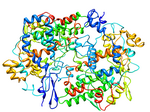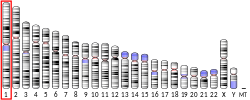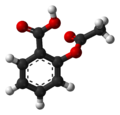Prostaglandins (PG) are a group of physiologically active lipid compounds called eicosanoids that have diverse hormone-like effects in animals. Prostaglandins...
26 KB (2,453 words) - 21:42, 14 November 2024
Prostaglandin F2α (PGF2α in prostanoid nomenclature), pharmaceutically termed dinoprost, is a naturally occurring prostaglandin used in medicine to induce...
12 KB (1,133 words) - 07:48, 16 September 2024
Prostaglandin E2 (PGE2), also known as dinoprostone, is a naturally occurring prostaglandin with oxytocic properties that is used as a medication. Dinoprostone...
35 KB (3,564 words) - 13:32, 19 November 2024
Prostaglandin E1 (PGE1) is a naturally occurring prostaglandin and is also used as a medication (alprostadil). In infants with congenital heart defects...
13 KB (1,105 words) - 07:16, 28 May 2024
Cyclooxygenase (redirect from Prostaglandin-endoperoxide synthase)
Cyclooxygenase (COX), officially known as prostaglandin-endoperoxide synthase (PTGS), is an enzyme (specifically, a family of isozymes, EC 1.14.99.1)...
16 KB (1,794 words) - 11:35, 14 November 2024
Prostaglandin H2 (PGH2), or prostaglandin H2 (PGH2), is a type of prostaglandin and a precursor for many other biologically significant molecules. It...
6 KB (505 words) - 07:56, 16 September 2024
Cyclooxygenase-1 (redirect from Prostaglandin-endoperoxide synthase 1)
Cyclooxygenase 1 (COX-1), also known as prostaglandin-endoperoxide synthase 1 (HUGO PTGS1), is an enzyme that in humans is encoded by the PTGS1 gene....
18 KB (2,122 words) - 12:15, 2 June 2024
Prostacyclin (redirect from Prostaglandin I2)
Prostacyclin (also called prostaglandin I2 or PGI2) is a prostaglandin member of the eicosanoid family of lipid molecules. It inhibits platelet activation...
20 KB (1,687 words) - 20:55, 12 September 2024
Prostaglandin analogues are a class of drugs that bind to a prostaglandin receptor. Wider use of prostaglandin analogues is limited by unwanted side effects...
3 KB (342 words) - 21:37, 11 July 2024
Prostaglandin inhibitors are drugs that inhibit the synthesis of prostaglandin in human body. There are various types of prostaglandins responsible for...
26 KB (2,117 words) - 14:49, 24 May 2024
Cyclooxygenase-2 (redirect from Prostaglandin-endoperoxide synthase 2)
Cyclooxygenase-2 (COX-2), also known as prostaglandin-endoperoxide synthase 2 (HUGO PTGS2), is an enzyme that in humans is encoded by the PTGS2 gene....
30 KB (3,416 words) - 23:50, 20 September 2024
growths in the intestinal tract. Overexpression of COX-2 produces excess prostaglandins, which have been shown to increase the possibility of colorectal cancer...
42 KB (4,944 words) - 11:56, 4 April 2024
Prostaglandin G2 (PGG2) is an organic peroxide belonging to the family of prostaglandins. The compound has been isolated as a solid, although it is usually...
3 KB (144 words) - 22:51, 20 September 2024
Prostaglandin E is a family of naturally occurring prostaglandins that are used as medications. Types include: Prostaglandin E1 also known as alprostadil...
5 KB (148 words) - 16:33, 31 October 2024
swelling from inflammation. It works by inhibiting the production of prostaglandins, endogenous signaling molecules known to cause these symptoms. It does...
23 KB (2,280 words) - 07:00, 5 November 2024
Prostaglandin EP3 receptor (EP3, 53kDa), is a prostaglandin receptor for prostaglandin E2 (PGE2) encoded by the human gene PTGER3; it is one of four identified...
37 KB (4,318 words) - 07:29, 25 November 2024
Prostaglandin E3 (PGE3) is a naturally formed prostaglandin and is formed via the cyclooxygenase (COX) metabolism of eicosapentaenoic acid. Prostaglandin...
2 KB (55 words) - 23:51, 3 April 2023
enzymes are involved in the synthesis of key biological mediators, namely prostaglandins, which are involved in inflammation, and thromboxanes, which are involved...
111 KB (11,577 words) - 07:56, 16 November 2024
in animal fats. It is a precursor in the formation of leukotrienes, prostaglandins, and thromboxanes. Together with omega−3 fatty acids and other omega−6...
21 KB (1,899 words) - 17:30, 2 October 2024
cyclooxygenase 1 and 2 (COX1 and COX2), thereby decreasing production of prostaglandins. Ketorolac was patented in 1976 and approved for medical use in 1989...
31 KB (2,646 words) - 16:31, 24 November 2024
Misoprostol (category Prostaglandins)
Misoprostol is a synthetic prostaglandin medication used to prevent and treat stomach and duodenal ulcers, induce labor, cause an abortion, and treat...
51 KB (4,767 words) - 18:40, 3 October 2024
The prostaglandin E2 (PGE2) receptors are G protein-coupled receptors that bind and are activated by prostaglandin E2. They are members of the prostaglandin...
5 KB (509 words) - 01:31, 17 December 2023
antipyretic effects. It acts by inhibiting the body's production of prostaglandin. It was patented in 1967 and approved for medical use in 1980. Ketoprofen...
18 KB (1,852 words) - 01:55, 20 September 2024
A prostaglandin antagonist is a hormone antagonist acting upon one or more prostaglandins, a subclass of eicosanoid compounds which function as signaling...
6 KB (768 words) - 10:51, 22 May 2024
Prostaglandin D2 (or PGD2) is a prostaglandin that binds to the receptor PTGDR (DP1), as well as CRTH2 (DP2). It is a major prostaglandin produced by...
11 KB (1,090 words) - 00:21, 17 February 2024
Aspirin (section Prostaglandins and thromboxanes)
production of prostaglandins and thromboxanes is due to its irreversible inactivation of the cyclooxygenase (COX; officially known as prostaglandin-endoperoxide...
155 KB (16,756 words) - 20:21, 11 November 2024
Prostaglandin E2 receptor 2, also known as EP2, is a prostaglandin receptor for prostaglandin E2 (PGE2) encoded by the human gene PTGER2: it is one of...
32 KB (3,685 words) - 02:56, 10 March 2024
known to convert dihomo-γ-linolenic acid and arachidonic acid into prostaglandins, and are the targets of nonsteroidal anti-inflammatory drugs (NSAIDs)...
20 KB (2,584 words) - 05:01, 11 May 2024
Bimatoprost (category Prostaglandins)
during pregnancy or breastfeeding is generally not recommended. It is a prostaglandin analog and works by increasing the outflow of aqueous fluid from the...
15 KB (1,174 words) - 05:56, 11 November 2024
Latanoprost (category Prostaglandins)
the eye, itchiness, and darkening of the iris. Latanoprost is in the prostaglandin analogue family of medications. It works by increasing the outflow of...
19 KB (1,575 words) - 11:38, 21 October 2024























